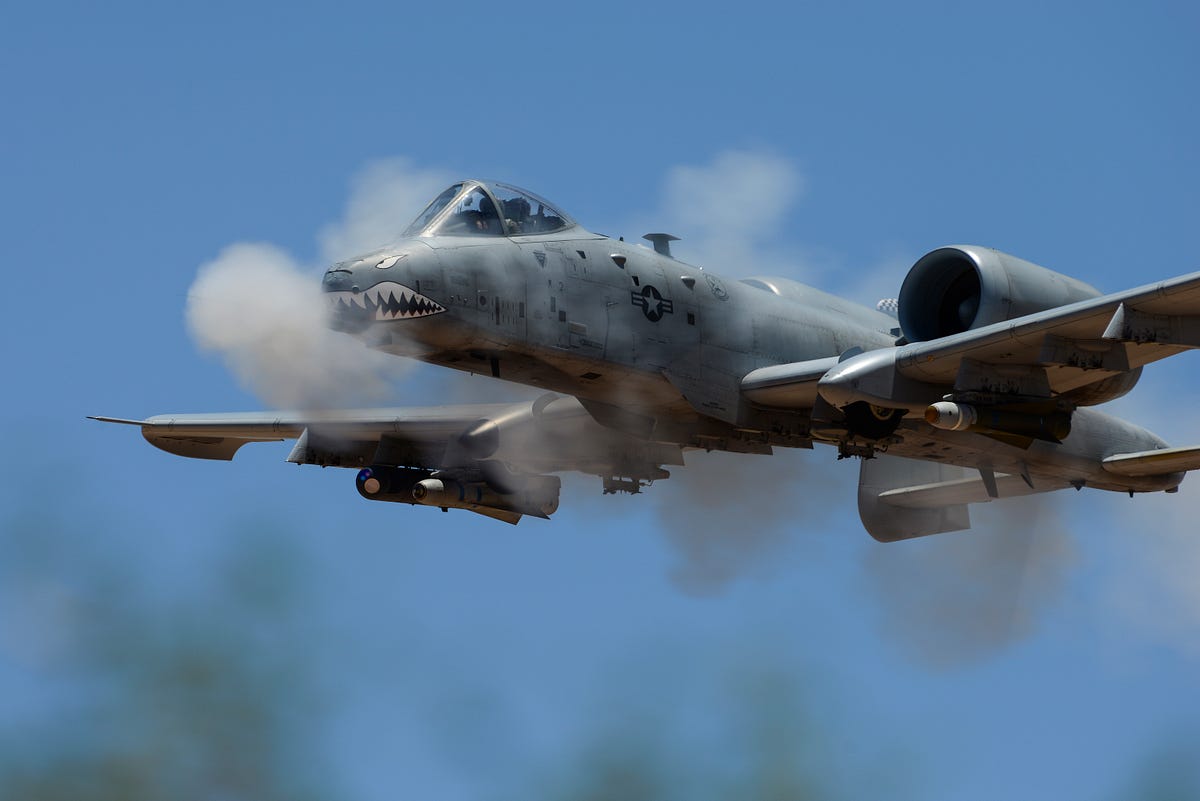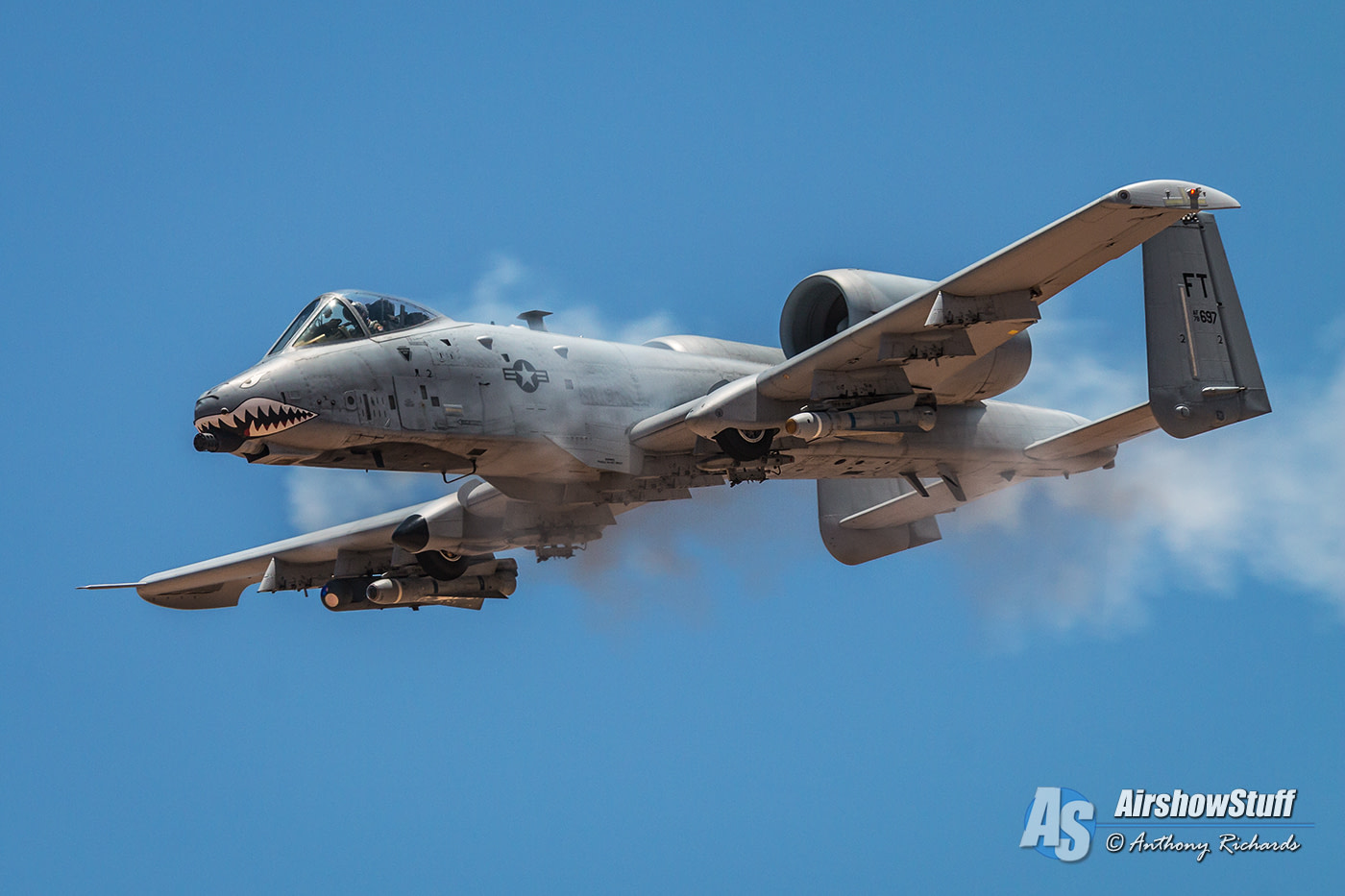A10 Strafe Run - Less commonly, the term is used to describe high-velocity fire from any land or naval aircraft (such as a fast ship) using small-caliber weapons and aiming at stationary or slow-moving targets.
The word is an adaptation of the German straf, punishment, especially a humorous adaptation of the anti-German British slogan Gott strafe gland (May God punish gland), dating back to World War I.
A10 Strafe Run

The gun calibers used ranged from 7.62–14.5 mm (0.300–0.571 in) machine guns to 20–40 mm (0.79–1.57 in) autocannons or rotary cannons. Although ground assaults with automatic weapons are often accompanied by bombing or rocket launches, the term "assault" does not specifically include the latter two.
Fairchild Republic A 10 Thunderbolt Ii
The term "shooting" can cover stationary firearms or aimable (flexible) firearms. Fixed machine guns firing straight forward are more dominant on fixed wing aircraft, while helicopters use TD gimbal weapons that can fire in many different directions no matter what direction the aircraft is pointing. (For the most part, flexible machine guns on fixed-wing aircraft are used for defensive purposes only, although they can sometimes be used to fire at ground targets with limited effectiveness).
Some fixed-wing aircraft, such as fighter-bombers, are capable of air combat missions or ground attack missions (P-47 Thunderbolt), while others are dedicated ground attack types (Il-2 Sturmovik). Where aircraft with both combat capabilities are assigned to the ground attack role, so the guns are expected to be used primarily for strafing, the installation of fixed weapons tends to be less and less the point of convergence. Longer range than for air combat. This is useful because it allows the pilot to target a target without diving to the ground, reducing the risk of hitting the ground and increasing the time available to shoot before taking to the air. And it will increase. Target range, which helps avoid damage from anti-aircraft fire and explosive targets.
Due to the low altitude and relatively low airspeed, precise strafing is required, which is extremely dangerous for the pilot, not only the danger of flying into the ground and wires such as wires, but also anti-aircraft weapons. These include surface-to-air missiles (vehicle-mounted and hand-held), anti-aircraft artillery, and small-caliber weapons fire (such as machine guns and small arms). Aircraft designed for ground attack may include additional armor around and under the cockpit and generator sets to protect the pilot and other vulnerable areas such as critical flight components, while aircraft designed for air combat are more likely to house most of their weapons to Protection directly from the front. Or in the rear, where other aircraft are more likely to fire, they are more likely to fire directly from below or from the sides, where most ground fire comes from.
Although military aircraft were originally used for artillery observation and guidance, they were frequently used in World War I. Strafing is used with machine guns that require high accuracy (for small targets), but non-strafing attacks (mainly small bombs) are more suitable for dealing with larger targets, area targets or low-altitude aircraft, which is very dangerous.
A 10 With Gau Gatling Gun Hi Res Stock Photography And Images
The German military was the first to introduce a class of aircraft designed for strafing ground attack aircraft. Ships designed for strafing included the German Junkers J.I during World War I, which was fitted with armor to protect it from ground fire. Junkers J.I. Both below are machine guns for firing.
These developments continued in specialized aircraft during World War II, including the concept of a heavily protected cockpit or "tub" to allow pilots to avoid backfire from anti-aircraft guns.
The best strafing aircraft of the Luftwaffe was the Junkers Ju 87 Stuka. The Ju 87 G variant had two Rheinmetall-Borsig 37 mm (1.5 in) Flak 18 guns, each mounted under the wings.

For the RAF, the best ground attack aircraft was the Hawke Hurricane II. It was armed with four 20 mm (0.79 in) wing cannons.
War Commander: Rogue Assault On Behance
The Hawker Typhoon was used later in the war. It had four "60-pound" RP-3 rockets.
The Republic P-47 Thunderbolt is one of the most important ground attack aircraft in the United States. It was armed with eight .50 caliber (12.7 mm) machine guns. Another important aircraft in this role was the North American B-25 Mitchell. It was used for low altitude strafing in the Pacific War.
The Russian Ilyushin IL-2 assault aircraft is one of Russia's most important ground attack aircraft. They are surrounded by heavy weapons, bottom and roof. It was armed with a 20, 23 or 37 mm (0.79, 0.91 or 1.46 in) cannon, depending on the model.
On 17 July 1944, a Spitfire of RCAF 412 Squadron, piloted by Charlie Fox, crashes Erwin Rommel's command vehicle near Sainte-Foy-de-Montgomery, suggesting his possible involvement in the 20 July 1944 Operation Valkyrie mutiny.
Survivor: How The Old A 10 Warthog Has Overcome Every Enemy
During the Korean War (1950-1953), USAF aircraft intercepted targets behind the front lines and influenced the development of ground warfare, but the strafing concept waned.
In the 1960s, when precision-guided munitions became common, they were unnecessarily dangerous, so some American fighter or attack aircraft (such as the F-4 Phantom and A-6 Intruder) were temporarily used. Cannon or machine gun. In the Vietnam War, this was found to be a deficiency and better "gunships" had to be used for reconnaissance. Gunships like the AC-47 Ghost, AC-119 Ghost, and early models of the AC-130 Ghost gunship proved to be devastating destroyers of troubled US Special Forces camps.
The A-10 Thunderbolt II is an American twin-engine, straight-wing jet developed by Fairchild-Republic in the early 1970s as the only US Air Force aircraft fully equipped with a ground-based close-combat aircraft. Design Aids. The A-10 is designed to engage tanks, armored vehicles and other ground targets with limited air defenses, usually by strafing.

The A-10 was built around the GAU-8 Avger, a 30 mm (1.2 in) rotating cannon that was the aircraft's primary armament and the heaviest automatic cannon mounted on an aircraft. The A-10's airframe is designed for survivability, such as 1,200 lb (540 kg) of armor protecting the cockpit and aircraft systems, allowing the aircraft to continue flying after significant damage. The official name of the A-10 comes from the World War II Republic P-47 Thunderbolt II, a fighter that was particularly effective in close air support. The A-10 is the main American aircraft designed for grand runs.
Top 10 Myths About The A 10 Thunderbolt Ii
Since 2001, coalition pilots in Iraq and Afghanistan have used strafing in support of ground forces in areas where explosive devices could cause unacceptable civilian casualties. The strafing of an F-16 aircraft is very dangerous for the pilot. During the Syrian civil war, the cities of Damascus and Aleppo were destroyed by helicopter gunships.
In 2004, the U.S. Air Force mistakenly destroyed a middle school in the country during a training exercise at Little Egg Harbor Middle School. Home Military Aviation 'Listening to door strafing was a bit of a f* *k when I got paid:' Story of A-10 pilot who loved listening to rock music during BRRRRTTTTT operations
"While I'm strafing, keep an eye on the door, it's a bit like getting paid to f**k:" Story of A-10 Pilot Loves Listening to Rock Music During BRRRRTTTTT Run
Despite being too busy listening to the radio and talking on the phone, and not allowed to carry electronic devices with them, fighter pilots sometimes break the rules and carry music players while flying.
Watch: See What It's Like To Be On The Receiving End Of An A 10 Warthog Strafing Run
Despite being too busy listening to the radio and talking, and not allowed to carry electronics with them (the likelihood of a gadget interfering with onboard avionics is very low, but it can happen), sometimes fighter pilots will break this rule and bring music . Player while flying.
"I ... uh, 'someone I know' ... has a 'patch card' (in exchange for a wise worker's insight in exchange for his favorite chest), Lynn Taylor, ex A-10 Pilot, Course Instructor and ALO, United Fires USAF (1995-2005), on Quora. 'It plugs in between the oxygen hose comms connection and the jet receptacle. It's a toggle switch that allows me to Connect a music player to the headset.
“I’ve only used it a few times, and even then, the only thing you can do on a cross-country flight is enjoy the view.” We have an inter-flight frequency that I can move to share the tune with my wingman, but it requires a constant hold of the mic button . Whenever we start approaching congested airspace, I turn it off to make sure we don't miss any messages from ATC.

"Any other time, you really don't want anything disturbing." Any other kind of assignment, training or otherwise, is a lot of work. "Especially in war, you don't want to worry about what's been thrown at you," Taylor noted.
The Explosive Rise In A 10 Warthog Strikes, Visualized
Anyway, back to
Strafe, a10 gun run ringtone, a10 strafing run, a10 run, a10 strafing run afghanistan, a10 com temple run, strafe jackets, strafe clothing, a10 warthog strafing run, strafe ski, strafe bibs, a10
0 Comments